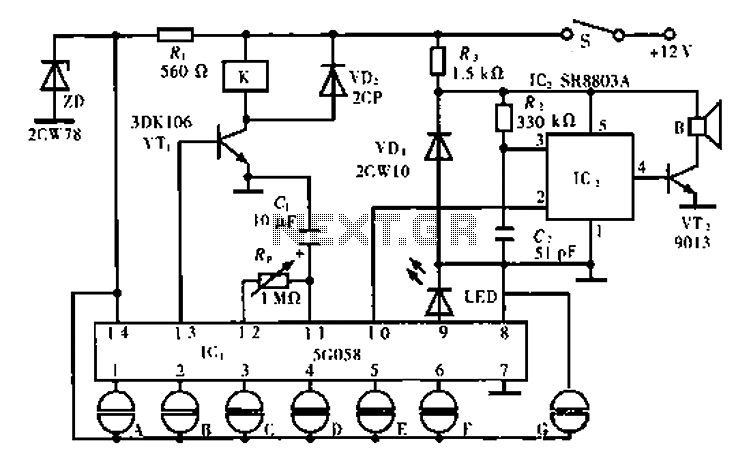
Door Bell Circuit Using BEL 188 PCB

This circuit is a low-cost, one-touch doorbell using a Bel 188 transistor. It is likely one of the most economical bell circuits that can be constructed. The core component of this circuit is the output transformer from a push-pull amplifier, commonly found in transistor radios, along with a Bel 188 PNP transistor. The sound produced by this doorbell circuit resembles a machine gun and activates whenever the switch is pressed. The sound begins loudly and gradually fades to silence. The circuit can be assembled on a standard PCB. It is designed to operate on a 9-volt supply, although it can function at lower voltages with a slight reduction in volume.
This low-cost doorbell circuit utilizes a Bel 188 PNP transistor, which acts as the primary switching element. The circuit design incorporates a push-pull amplifier output transformer, which is integral for generating the sound output. When the switch is activated, the transistor conducts, allowing current to flow through the transformer. This action generates an audible signal that begins at a high volume and tapers off, creating a distinctive sound effect reminiscent of a machine gun.
The circuit's design allows for flexibility in power supply. Although it is optimized for a 9-volt supply, it can operate at lower voltages, such as 6 volts, with a corresponding decrease in sound intensity. This adaptability makes it suitable for various applications where power supply options may vary.
Assembly of the circuit is straightforward, as it can be mounted on a standard printed circuit board (PCB). This feature simplifies the construction process and enhances the reliability of the connections. The components required for this circuit are readily available, making it an accessible project for both novice and experienced electronics enthusiasts.
In summary, this one-touch doorbell circuit is an economical solution for creating an audible alert system. Its unique sound profile, combined with its simple construction and adaptability to various voltage levels, makes it a practical choice for a wide range of applications.Circuit Here is a low cost one touch door bell circuit using Bel 188 transistor. I think this may be the most cheap bell circuit that can be made. The core of this circuit is a output transformer of push-pull amplifier that often used in transistor radios and a Bel 188 PNP transistor. The sound produced from the circuit of calling bell is a machin e gun like and it produces when ever we press the switch. It starts from loud and then fade out to silence. The circuit can be assembled on a common PCB. This door bell circuit is designed to work on a 9 Volt supply but it may works even low voltages at the cost of slightly reduced volume. 🔗 External reference
This low-cost doorbell circuit utilizes a Bel 188 PNP transistor, which acts as the primary switching element. The circuit design incorporates a push-pull amplifier output transformer, which is integral for generating the sound output. When the switch is activated, the transistor conducts, allowing current to flow through the transformer. This action generates an audible signal that begins at a high volume and tapers off, creating a distinctive sound effect reminiscent of a machine gun.
The circuit's design allows for flexibility in power supply. Although it is optimized for a 9-volt supply, it can operate at lower voltages, such as 6 volts, with a corresponding decrease in sound intensity. This adaptability makes it suitable for various applications where power supply options may vary.
Assembly of the circuit is straightforward, as it can be mounted on a standard printed circuit board (PCB). This feature simplifies the construction process and enhances the reliability of the connections. The components required for this circuit are readily available, making it an accessible project for both novice and experienced electronics enthusiasts.
In summary, this one-touch doorbell circuit is an economical solution for creating an audible alert system. Its unique sound profile, combined with its simple construction and adaptability to various voltage levels, makes it a practical choice for a wide range of applications.Circuit Here is a low cost one touch door bell circuit using Bel 188 transistor. I think this may be the most cheap bell circuit that can be made. The core of this circuit is a output transformer of push-pull amplifier that often used in transistor radios and a Bel 188 PNP transistor. The sound produced from the circuit of calling bell is a machin e gun like and it produces when ever we press the switch. It starts from loud and then fade out to silence. The circuit can be assembled on a common PCB. This door bell circuit is designed to work on a 9 Volt supply but it may works even low voltages at the cost of slightly reduced volume. 🔗 External reference





